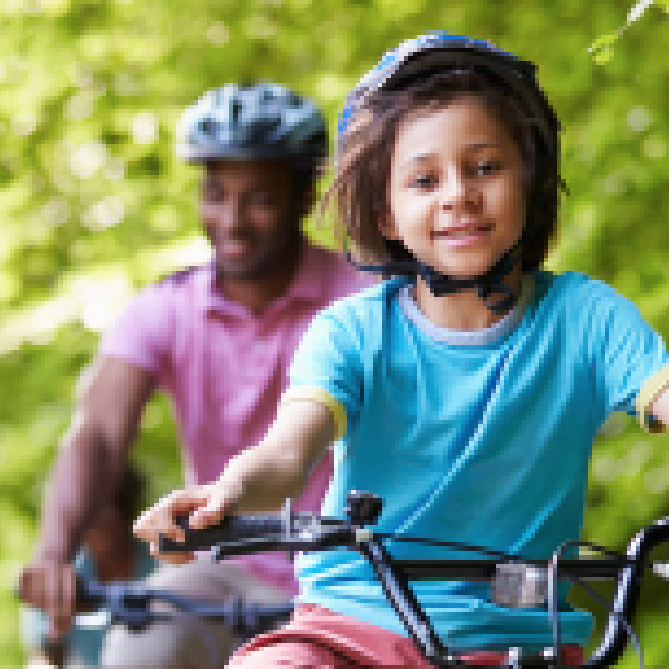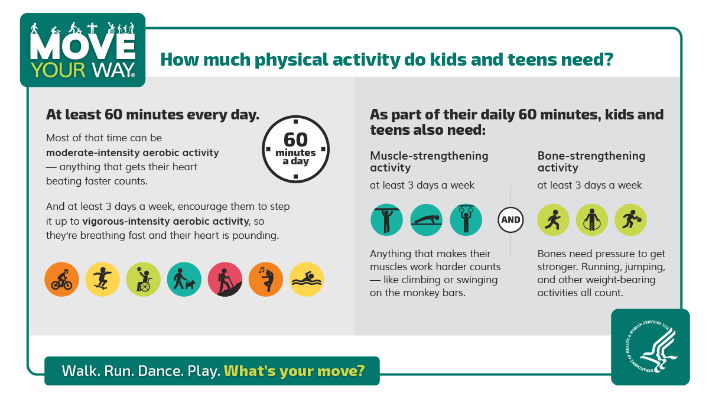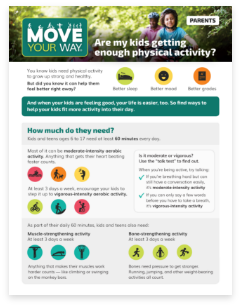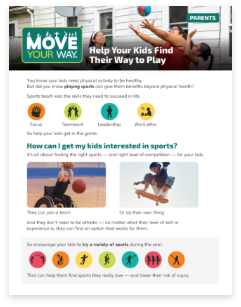Making sure kids stay active with age-appropriate, enjoyable physical activities can be challenging. How much do they need? Are they getting the right type of exercise? And perhaps most importantly, how can you keep them motivated? If you are looking for answers to these questions, you’ve come to the right place!
How much activity do they need?
The amount of physical activity children need depends on their age. Children ages 3 through 5 years need to be active throughout the day. Children and adolescents ages 6 through 17 need to be active for 60 minutes every day.
This may sound like a lot, but don’t worry! Your kids may already be meeting the recommended physical activity levels because lots of activities count. The Centers for Disease Control and Prevention (CDC) recommends following the Physical Activity Guidelines for Americans for growth and development.
Children ages 3–5 years
Younger kids love to be active naturally. Aim to keep them physically active throughout the day—a good goal is 3 hours of moving. Consider encouraging activities such as:
- Games like Duck, Duck, Goose or Follow the Leader
- Animal walk (name an animal and move like they do!)
- Freeze tag
- Dancing
- Kicking a ball back and forth or into a goal
- Running, jumping, or throwing
- Hopscotch
- Bean bag toss
Kids and teens ages 6–17 years
Older kids need 60 minutes or more of moderate-to-vigorous intensity physical activity each day.
Most of the 60 minutes can be moderate-intensity aerobic activity. Anything that gets their heart beating faster counts. This can include activities like:
- Walking
- Hiking
- Biking
- Dancing
- Swimming
- Playing games that involve catching and throwing
- Yard work
At least 3 days a week kids and teens should step it up to vigorous-intensity aerobic activity, so they’re breathing fast and their heart is pounding.
As part of their 60 minutes, kids also need:
Muscle-strengthening activities are things that make their muscles work harder like:
- Climbing
- Yoga
- Doing push-ups
- Swinging on the monkey bars
- Rope or tree climbing
- Resistance exercises using body weight or resistance bands
Bone-strengthening activities are important because bones need pressure to get stronger. This includes activities such as:
- Jumping
- Running
- Mountain biking
- Martial arts
- Skiing
- Team sports such as soccer, basketball, volleyball, or tennis
Take the talk test
A good rule of thumb to help you know if an activity is moderate or vigorous is to use the “talk test.” When your child is being active, ask them to talk to you:
- If they are breathing hard but can still have a conversation easily, it’s moderate-intensity activity
- If they can only saw a few words before having to take a breath, it’s vigorous-intensity activity
What are the benefits of being active?
Physical activity has many health benefits for children and teens. It can improve thinking and cognition, reduce the risk of disease, strengthen bones and muscles, and improve their ability to do everyday activities.
Regular physical activity also creates lifelong habits that can greatly improve overall health as kids grow older. But did you know it can make them feel better right away? That’s right! A little physical activity can:
- Help kids sleep better
- Boost mood
- Even help them get better grades
How can I keep them motivated?
There are many ways to help encourage kids to stay active. Be positive about all kinds of physical activity and make it easy for them to get involved. Remember: whatever keeps them moving counts!
Here are a few ideas and some tips to consider:
- Choose activities that are developmentally appropriate. If an activity feels too hard or scary, they may not want to try it again.
- Plan ahead and dress them appropriately. If it’s hot, make sure they have water. If it’s cold, grab a hat and gloves. Gonna take a while? Bring a healthy snack.
- Expose them to lots of activities, games, and sports, and ask them to tell you the things they like most about each.
- Provide active toys (balls, jump ropes, etc.) for younger kids
- Sign them up for free or low-cost sports or classes.
- Get the right gear or equipment for older kids.
- Set limits. Limit screen time on TV, devices, and computers.
- Make time for exercise. Homework, music lessons, and other planned activities are important but make sure kids have time for play and exercise too.
- Don’t overdo it. Exercise and physical activity should not hurt. If it becomes painful, your child should slow down or try a less vigorous activity.
What Can I Do to Encourage Physical Activity?
Parents and caregivers play a key role in helping their child be more physically active. Remember:
- Focus on having fun. Help them find the activities they enjoy most. Talk about it. Get involved. It can be a great way for the whole family to spend time together.
- Encourage active play with friends.
- Give them rewards for active chores.
- Play with your children. Help them learn a new sport or enjoy physical activity with them by going for a walk, hike, or bike ride.
- Get active together. Make your morning walk a race, dance while dinner’s in the oven, show them your favorite ways to move.
- Be a role model. When kids see adults being active, they are more likely to be active too!
What’s your move?
The Move Your Way® campaign can help parents and caregivers understand the amount and types of physical activity kids need to be healthy. The Move Your Way® materials include:
- Fact Sheets and posters
- An interactive tool
- Videos
- Stories about physical activity and healthy eating
- Sample social media messages, graphics, and GIFs
These materials can be displayed or distributed in health care settings, recreation facilities, schools, workplaces, community centers, and more.
Download the fact sheets below for information about:
- The kinds of activity kids and teens need to stay healthy
- Tips for helping kids get active
- Benefits kids and teens can get from playing sports
Explore More from Move Your Way®
Move Your Way® South Dakota Playbook
Find out how to promote, support, and encourage physical activity in your community
Move Your Way® During and After Pregnancy
Learn the benefits of physical activity during and after pregnancy.




